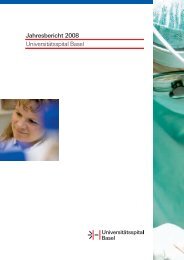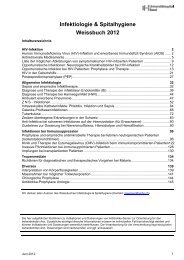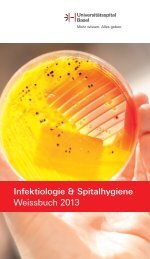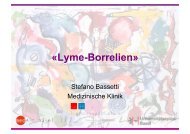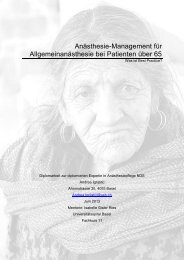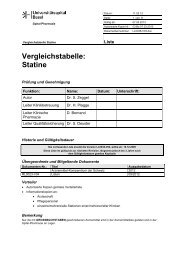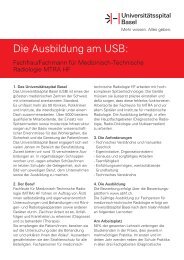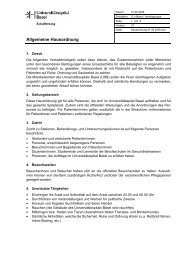Transmucosal Nasal Drug Delivery: Systemic Bioavailability of ...
Transmucosal Nasal Drug Delivery: Systemic Bioavailability of ...
Transmucosal Nasal Drug Delivery: Systemic Bioavailability of ...
You also want an ePaper? Increase the reach of your titles
YUMPU automatically turns print PDFs into web optimized ePapers that Google loves.
6. Project II: Pharmacokinetic <strong>of</strong> transmucosal nasal delivered midazolam – impact <strong>of</strong> adjuvants<br />
<strong>Transmucosal</strong> nasal midazolam absorption was promoted by chitosan hydrochloride. Chitosan<br />
hydrochloride modified absorption kinetics (C max and t max ) <strong>of</strong> nasally applied midazolam (3 mg), but<br />
overall systemic bioavailability was not enhanced.<br />
Furthermore, smaller ranges for AUC, t max , and C max observed after nasal administration <strong>of</strong> 3 mg<br />
(Preparation 5) refer to less interindividual variability and therefore reproducible pharmacokinetics.<br />
Bioequivalence testing was performed for all assessed pharmacokinetic parameters (AUC, t max ,<br />
and C max ) following nasal administration <strong>of</strong> Preparation 4 (reference preparation) and Preparation 5<br />
(test preparation). None <strong>of</strong> the tested parameters (AUC, t max , and C max ) following nasal<br />
administration <strong>of</strong> Preparation 5 fulfilled the requirements <strong>of</strong> the EMEA for bioequivalence.<br />
Accordingly, bioequivalence was not confirmed for Preparation 4 (3 mg midazolam, no chitosan<br />
hydrochloride) and Preparation 5 (3 mg midazolam, 0.5% chitosan hydrochloride).<br />
Chitosan hydrochloride (Preparation 5) promoted absorption kinetics <strong>of</strong> nasally applied midazolam<br />
and significant higher midazolam serum concentrations were faster achieved. Chitosan<br />
hydrochloride proved valuable penetration enhancer abilities in transmucosal nasal midazolam<br />
delivery. Chitosan hydrochloride potentially facilitates optimization <strong>of</strong> nasal midazolam preparation<br />
for indications requiring fast onset <strong>of</strong> therapeutic effects (e.g., status epilepticus). Chitosan<br />
containing nasal midazolam preparations are a promising therapeutic alternative to i.v. delivered<br />
midazolam for the treatment <strong>of</strong> status epilepticus. Providing reliable anticonvulsive therapy the<br />
more intense nasal irritation, <strong>of</strong> chitosan containing nasal midazolam preparation (Preparation 5) is<br />
<strong>of</strong> secondary importance compared to the benefit <strong>of</strong> needle-free drug delivery.<br />
The congruent metabolite pr<strong>of</strong>ile after nasal and i.v. administration <strong>of</strong> 1 mg midazolam supports the<br />
presumption <strong>of</strong> direct midazolam uptake through nasal mucosa into the systemic circulation. Apart<br />
from slightly earlier peak concentration after i.v. administration, the metabolite pr<strong>of</strong>iles after nasal<br />
and i.v. administration <strong>of</strong> 1 mg midazolam are congruent. In addition, the constant AUC (dose<br />
adjusted) <strong>of</strong> α-hydroxymidazolam following nasal and i.v. administration <strong>of</strong> midazolam attests<br />
effective bypassing <strong>of</strong> the first-pass metabolism. Thus, serum concentration time pr<strong>of</strong>iles <strong>of</strong> the<br />
midazolam metabolites (α-hydroxymidazolam and 4-hydroxymidazolam) demonstrated exclusive<br />
transmucosal absorption <strong>of</strong> nasally applied midazolam.<br />
<strong>Nasal</strong> administration <strong>of</strong> 0.1 ml prevented swallowing <strong>of</strong> the nasally delivered preparation,<br />
gastrointestinal midazolam uptake, and reduction <strong>of</strong> systemic bioavailability by hepatic first-pass<br />
metabolism. Consequently, the assessed pharmacokinetic parameters characterized pure<br />
transmucosal nasal midazolam delivery.<br />
This interpretation <strong>of</strong> metabolite pr<strong>of</strong>iles is in accordance with the findings <strong>of</strong> Heizmann et al., who<br />
demonstrated higher plasma levels for α-hydroxymidazolam following oral administration <strong>of</strong><br />
midazolam compared to i.v. midazolam delivery [Heizmann et al., 1983]. Illum et al. were the first<br />
who proved direct transmucosal nasal drug uptake based on the characterization <strong>of</strong> drug and<br />
metabolite concentration time pr<strong>of</strong>iles [Illum, et al. 2002].<br />
Katja Suter-Zimmermann Page 80 <strong>of</strong> 188 University <strong>of</strong> Basel, 2008




